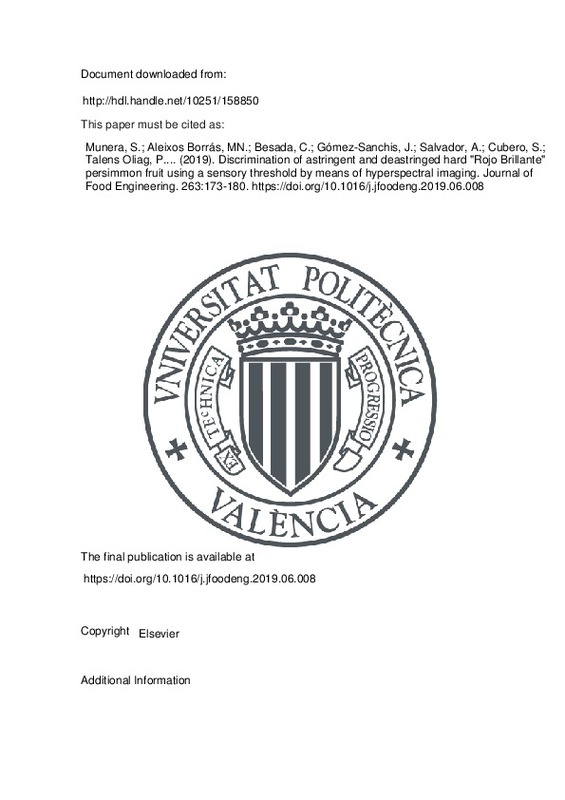JavaScript is disabled for your browser. Some features of this site may not work without it.
Buscar en RiuNet
Listar
Mi cuenta
Estadísticas
Ayuda RiuNet
Admin. UPV
Discrimination of astringent and deastringed hard "Rojo Brillante" persimmon fruit using a sensory threshold by means of hyperspectral imaging
Mostrar el registro sencillo del ítem
Ficheros en el ítem
| dc.contributor.author | Munera, Sandra
|
es_ES |
| dc.contributor.author | Aleixos Borrás, María Nuria
|
es_ES |
| dc.contributor.author | Besada, Cristina
|
es_ES |
| dc.contributor.author | Gómez-Sanchis, Juan
|
es_ES |
| dc.contributor.author | Salvador, Alejandra
|
es_ES |
| dc.contributor.author | Cubero, Sergio
|
es_ES |
| dc.contributor.author | Talens Oliag, Pau
|
es_ES |
| dc.contributor.author | Blasco, José
|
es_ES |
| dc.date.accessioned | 2021-01-12T21:03:08Z | |
| dc.date.available | 2021-01-12T21:03:08Z | |
| dc.date.issued | 2019-12 | es_ES |
| dc.identifier.issn | 0260-8774 | es_ES |
| dc.identifier.uri | http://hdl.handle.net/10251/158850 | |
| dc.description.abstract | [EN] Persimmon fruit cv. 'Rojo Brillante' is an astringent cultivar due to its content of soluble tannins, which are insolubilised during the ripening of the fruit. Traditionally, the consumption of this cultivar has only been possible when the fruit is overripe and the texture is soft. Postharvest treatments based on exposing fruits to high CO2 concentrations allow astringency removal while preserving high flesh firmness. However, the effectiveness of this treatment is controlled by means of slow destructive methods. The aim of this work is to study the application of hyperspectral imaging in the spectral range 450-1040 nm to discriminate astringent (A) and deastringed (DA) fruits non-destructively. To separate both type of fruit, it was used a threshold of soluble tannins based on sensorial perception (0.04% of fresh weight). The spectral information from three different areas of each fruit (calyx, middle and apex) was used to build models to predict the soluble tannins (ST) content using partial least squares regression (PLS-R). The results using this method indicated that it was not possible to accurately discriminate fruit with levels of ST below 0.04%, especially in the case of DA fruits (42.2%). Thus, another classification models were performed using partial least squares discriminant analysis (PLS-DA) that included other properties in order to discriminate between A and DA using the ST threshold. The most accurate models using all and optimal wavelengths selected were those which focused on the middle and apex areas of the fruit, a correct classification rate of 87.0% being achieved for A fruits and above 84.4% for DA fruits. To date, there are only subjective and destructive analytical methods to monitor the effectiveness of the astringency removal treatments in persimmon. The results obtained in this study indicate that hyperspectral images can therefore be considered as an objective and non-destructive alternative in the control of this process. | es_ES |
| dc.description.sponsorship | This work was partially funded by INIA and FEDER funds through project RTA2015-00078-00-00. Sandra Munera thanks INIA for the FPI-INIA grant num. 43 (CPR2014-0082), partially supported by European Union FSE funds. | es_ES |
| dc.language | Inglés | es_ES |
| dc.publisher | Elsevier | es_ES |
| dc.relation.ispartof | Journal of Food Engineering | es_ES |
| dc.rights | Reconocimiento - No comercial - Sin obra derivada (by-nc-nd) | es_ES |
| dc.subject | Diospyros kaki | es_ES |
| dc.subject | Astringency | es_ES |
| dc.subject | Soluble tannins | es_ES |
| dc.subject | Computer vision | es_ES |
| dc.subject | Chemometrics | es_ES |
| dc.subject.classification | EXPRESION GRAFICA EN LA INGENIERIA | es_ES |
| dc.subject.classification | TECNOLOGIA DE ALIMENTOS | es_ES |
| dc.title | Discrimination of astringent and deastringed hard "Rojo Brillante" persimmon fruit using a sensory threshold by means of hyperspectral imaging | es_ES |
| dc.type | Artículo | es_ES |
| dc.identifier.doi | 10.1016/j.jfoodeng.2019.06.008 | es_ES |
| dc.relation.projectID | info:eu-repo/grantAgreement/INIA//CPR2014-0082/ | es_ES |
| dc.relation.projectID | info:eu-repo/grantAgreement/UPV//2745/ES/Desarrollo de Tecnicas No Destructivas en Vision por Computador y Tecnologias de Automatización para la Clasificacion de Productos Hortofruticolas en Base a sus Propiedades Opticas y Mecanicas/ | es_ES |
| dc.relation.projectID | info:eu-repo/grantAgreement/MINECO//RTA2012-00062-C04-03/ES/Nuevas técnicas de inspección basadas en visión por computador multiespectral para la estimación de propiedades y determinación automática de la calidad y sanidad de la producción agroalimentaria en líneas de inspección y manipulación (VIS-DACSA)/ | es_ES |
| dc.relation.projectID | info:eu-repo/grantAgreement/GVA//AICO%2F2015%2F122/ | es_ES |
| dc.rights.accessRights | Abierto | es_ES |
| dc.contributor.affiliation | Universitat Politècnica de València. Departamento de Ingeniería Gráfica - Departament d'Enginyeria Gràfica | es_ES |
| dc.contributor.affiliation | Universitat Politècnica de València. Departamento de Tecnología de Alimentos - Departament de Tecnologia d'Aliments | es_ES |
| dc.contributor.affiliation | Universitat Politècnica de València. Departamento de Mecanización y Tecnología Agraria - Departament de Mecanització i Tecnologia Agrària | es_ES |
| dc.description.bibliographicCitation | Munera, S.; Aleixos Borrás, MN.; Besada, C.; Gómez-Sanchis, J.; Salvador, A.; Cubero, S.; Talens Oliag, P.... (2019). Discrimination of astringent and deastringed hard "Rojo Brillante" persimmon fruit using a sensory threshold by means of hyperspectral imaging. Journal of Food Engineering. 263:173-180. https://doi.org/10.1016/j.jfoodeng.2019.06.008 | es_ES |
| dc.description.accrualMethod | S | es_ES |
| dc.relation.publisherversion | https://doi.org/10.1016/j.jfoodeng.2019.06.008 | es_ES |
| dc.description.upvformatpinicio | 173 | es_ES |
| dc.description.upvformatpfin | 180 | es_ES |
| dc.type.version | info:eu-repo/semantics/publishedVersion | es_ES |
| dc.description.volume | 263 | es_ES |
| dc.relation.pasarela | S\408771 | es_ES |
| dc.contributor.funder | Generalitat Valenciana | es_ES |
| dc.contributor.funder | European Regional Development Fund | es_ES |
| dc.contributor.funder | Universitat Politècnica de València | es_ES |
| dc.contributor.funder | Ministerio de Economía y Competitividad | es_ES |







![[Cerrado]](/themes/UPV/images/candado.png)

